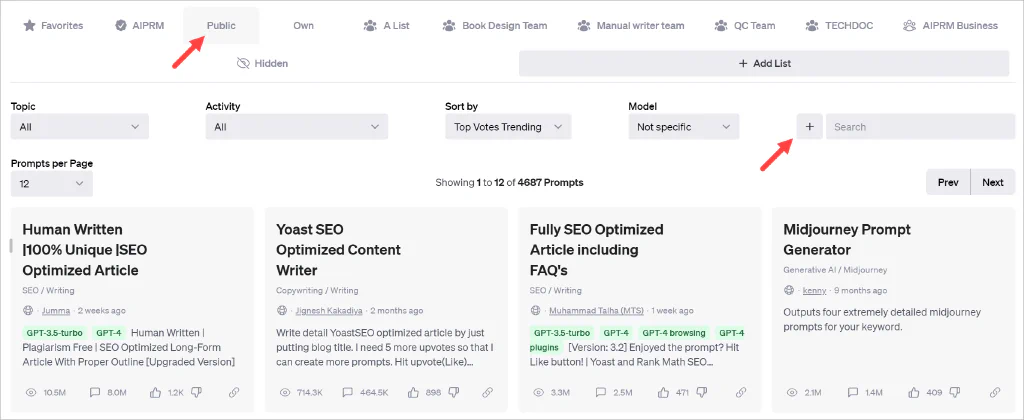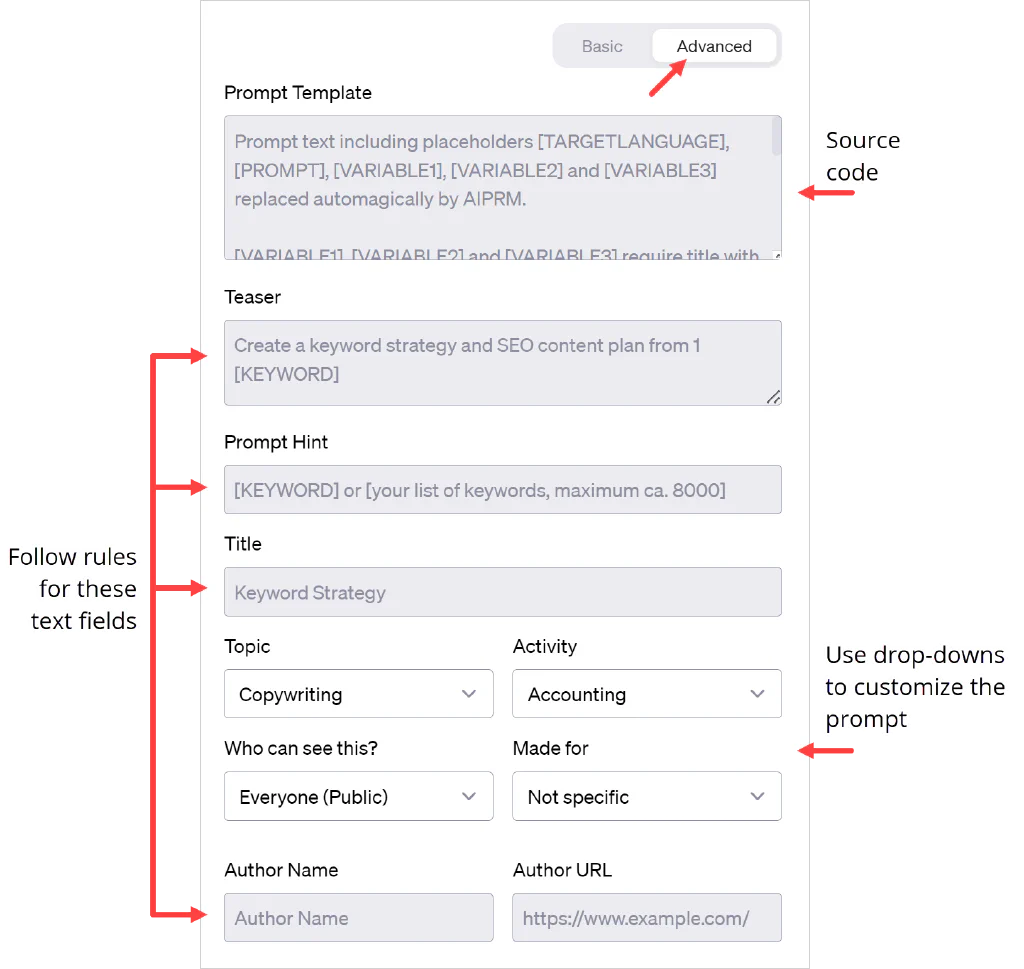How to Write Public Prompt Templates for AIPRM
How to write public prompt templates for AIPRM #
Follow these guidelines to ensure your prompts, and your access to AIPRM, are maintained.
A video walkthrough on creating and sharing prompt templates in AIPRM #
A public prompt template is a document that you create and share with the AIPRM community. Anybody with the AIPRM extension can see and use public templates, which means your work will be available to 100,000s of users.
To ensure a minimum standard of quality, we developed a few guidelines. Build your prompt with these standards in mind. No coding skills are required. All you need is a bit of time and a good idea.
There are four main sections in this article:
- Opening the template page
- Entering Prompt Template source code
- Writing effective descriptions
- Adding author credits
Opening the template page #
The first step is to open a blank template.
- Open ChatGPT and sign into your AIPRM account.
- Go to the AIPRM dashboard and click the Public tab.
- Click the plus (+) icon. A popup displays.
- Go to the top of the popup and click the Advanced tab.

Understanding form organization #
The popup displays a blank template form. There are three main sections.
-
Prompt Template - Enter your instructions for the AI. The field has two important placeholders that you must use: [PROMPT] and [TARGETLANGUAGE], which are described below. You can also use one or more [VARIABLE] placeholders. A different article describes AIPRM prompt variables.
-
Text fields - Fill in these fields with accurate and descriptive information. Be sure to read and follow our rules for these fields (see below). These rules help creators produce useful templates that meet a minimum standard of quality.
-
Drop-down fields - Use the fields to customize the template. Be sure to click the Who can see this? field and select Only me (Private) while you build the template. When it’s complete, select the Everyone (Public) option.

Entering Prompt Template source code #
Follow these rules when writing text for the Prompt Template field to promote usability and stability.
Ensuring usability #
Reusability #
Prompts should not be written for only one topic (e.g. Write about GSCE exam). Instead, the user must be able to insert variable data using the [PROMPT] placeholder.
Here are some examples of phrases that you could use in the Prompt Template field:
- The keywords to use in the analysis are [PROMPT].
- Please use the keywords [PROMPT] and…
Multilingual support #
Write a prompt that members of our international community can use. That means the output language must be a variable. You cannot, for instance, write a prompt template that generates an output in a single language. In the Prompt Template field, use the placeholder [TARGETLANGUAGE] in the text.
Example phrases to use:
- I want you to act as a blog post title writer that speaks and writes fluent [TARGETLANGUAGE].
- You will reply with blog post titles in [TARGETLANGUAGE].
- Write all output in [TARGETLANGUAGE].
Creating stability #
ChatGPT is sometimes like a stubborn little child. It doesn’t always want to follow instructions. As a prompt engineer, your job is to ensure ChatGPT follows the template’s instructions. Use these four tips to craft prompt template text so that ChatGPT generates on-target outputs.
-
Reset the model at the start. Add a sentence like, Please ignore all previous instructions. This reset tells ChatGPT to forget any previous context it had. Remember, ChatGPT is innovative because it is a dialogue-specific model. It remembers what was discussed before. The reset instruction makes ChatGPT forget the past, so you have a clean and consistent start.
-
Frame the role of a model at the start. Add a sentence like, I want you to act as a very proficient SEO and high-end copywriter that speaks and writes fluent [TARGETLANGUAGE]. Note we pass the language placeholder here. We may need to use it again, but this is a good start. Depending on the task, it is important to tell ChatGPT to switch writing roles. Copywriters don’t write like SEO writers, who don’t write like attorneys, for example.
-
Test your prompt and if needed reassure the model to be capable. This is where you (qua prompt engineer) have to motivate the model. Strange, but true. You have to convince the AI model like a junior developer. “Yes," you say to the AI, “I know you can do this.” If you’re writing an SEO-related prompt, you might add something like, I want you to pretend that you can write content so well in [TARGETLANGUAGE] that it can outrank other websites.
-
Test your prompt in various settings. To make sure your prompt is valuable to yourself and the community, run your prompt template with different topics and languages. If you speak only one language, run the output through Google Translate and see what it says when you translate it back to English. If you don’t test your prompt, the results will be very frustrating. Expect to test and retest for a few hours before you have a prompt that generates excellent content for a specific version of the model.
Sample Prompt Template source code #
Based on the above reusability and stability tips, we created text for the Prompt Template field. Feel free to copy this passage to a text editor and modify it for your purposes.
Please ignore all previous instructions. I want you to respond only in language [TARGETLANGUAGE]. I want you to act as a very proficient SEO and high end copywriter that speaks and writes fluently [TARGETLANGUAGE]. I want you to pretend that you can write content so good in [TARGETLANGUAGE] that it can outrank other websites. Your task is to summarize the text I give you in 20 words or a maximum 130 characters. All output shall be in [TARGETLANGUAGE]. The text to summarize is this:
[PROMPT]
When a user runs a prompt with the above text in the Prompt Template field, the following actions take place:
- AIPRM replaces the placeholder [TARGETLANGUAGE] with the language you selected in the drop-down menu. If the Prompt Template doesn’t contain this placeholder, the prompt won’t work for multiple languages.
- We use [TARGETLANGUAGE] four (!) times in the Prompt Template to reassure ChatGPT that it can speak that language and convince it to write in our preferred language.
- AIPRM replaces the placeholder [PROMPT] with the text you typed into the prompt input field. If the Prompt Template doesn’t contain this placeholder, the prompt won’t work for multiple topics.
Writing effective descriptions #
Each prompt template has three description fields: Teaser, Prompt Hint, and Title. Make sure the text in these fields is well-written, and contains enough specific detail. Write the descriptions in English. Text in the Prompt Template field can be written in another language.
When creating text for these three fields, be sure to follow these rules:
-
DO NOT advertise your brand or domain name in the Title field. That is considered spam and will be removed.
-
DO NOT use Emojis.
-
DO NOT enter irrelevant text or blatant spam.
-
DO NOT include typos.
-
DO NOT use these words in your descriptions: Real-Time, Live, or Crawl - except when you use the AIPRM Live Crawling Feature in your prompt.
Teaser #
In a few words, explain what the prompt does. Write up to three sentences with punctuation.
Examples of good teasers:
- Human Written | Plagiarism Free | SEO Optimized Long-Form Article With Proper Outline.
- Outrank the competition with an in-depth, SEO-optimized article based on [YOUR COMPETITOR URL]. Be like your competition, just a little better ;-).
- Write a full book with different chapters.
Prompt Hint #
Be as specific as possible. Short form is okay with keywords or all caps. Tell the user what they need to enter into the field. When a user selects a prompt, ChatGPT displays this instructional text in the input field.
Example phrases to use:
- [Enter keyword or title here]
- [keyword]
- [Your competition URL]
Title #
The text in the Title field works like an email Subject line. If it communicates a benefit or clear message, the user is more likely to open it.
- Keep the title short.
- Describe what the prompt template does. Avoid generic language like, Improve your efficiency.
- Use Title Case and not lowercase or all uppercase.
Examples of titles from some popular public prompts:
- Yoast SEO Optimized Content Writer
- Write Best Article to Rank on Google
- Blog Post Title Generator
Adding author credits #
Author Name #
You can promote your company or business with your name at a reasonable length. If you enter a CTA or promo text, we’ll remove the prompt. DO NOT add an emoji.
Author URL #
You can promote your company or business by adding a link to these types of content:
- Prompt explanations.
- Examples of how to use the prompt.
- Descriptions of the company or business.
- Tracking parameters are OK (e.g. &utm_….).
- A company homepage is acceptable for now, but we will block links to random blog content at a later date.
Links to these types of content are NOT allowed:
- Direct affiliate pages.
- Unrelated content (e.g. a Forex-Trading service or diet pill store).
- Sources that install software, extensions, malware, or viruses.
- Offers obviously not related to you, your prompt, ChatGPT, or AIPRM.
FAQ on AIPRM Prompt Template Engineering #
But this is like coding. I'm not a developer.
Yes, it is like coding. No, you don’t need to be a developer if you can understand the principle of text replacements from (your input text) into the [PROMPT] placeholder.
What if I need the prompt template only in Language XYZ?
That’s fine, then keep it private. Most users in the USA will NOT need a Prompt Template that instructs the model to answer in Portuguese. Most users in Germany will NOT need a Prompt Template that instructs the model to answer in Italian. Does that make sense?
What if I need the prompt only for my niche ABC?
That’s fine, then keep it private. Public prompts must work for many topics and all languages AIPRM supports.
OMG, this AIPRM prompt engineering is too much hassle for me!
Yes, prompt engineering is hard work. Your job and goal are to produce reproducible, stable, reusable, and multi-lingual prompts if you want them public in AIPRM. If you don’t want to put in that work, that’s fine. But your prompts won’t be published to the public Community of AIPRM. You can still use them for yourself.
Table of Contents
2M+ Users


Featured
Introducing Teams: Share Your Prompts
Share your ChatGPT prompt library with your team, Choose from thousands of pre-built prompts for marketing, SEO, sales, productivity, SaaS, and more.
Already have the extension?
Subscribe to a Premium Plan.